Comparison of On-Premise, Hosted and Cloud ERP Systems
VerifiedAdded on 2023/06/05
|18
|4263
|453
AI Summary
This report discusses the three Enterprise Resource Planning systems: On-premise, Hosted and Cloud ERP systems. It explains the topics on each one of them, the associated benefits, risks and some of the challenges they face in cases where companies may opt to use them. The report also includes a comparison and contrast between the three systems in terms of cost, security, scalability and deployment, and user access. Case studies of Cadbury and Hershey's companies are also included.
Contribute Materials
Your contribution can guide someone’s learning journey. Share your
documents today.
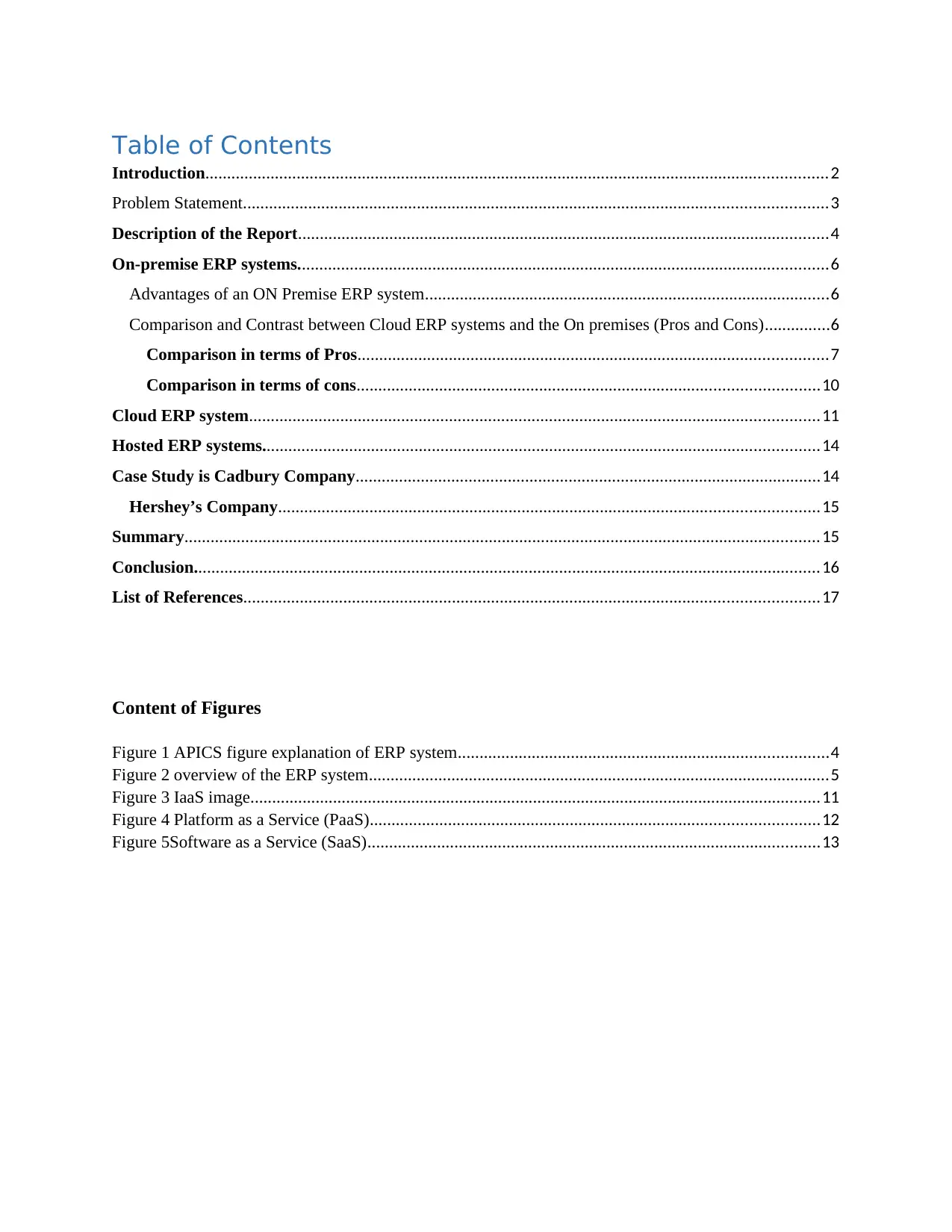
Table of Contents
Introduction...............................................................................................................................................2
Problem Statement......................................................................................................................................3
Description of the Report..........................................................................................................................4
On-premise ERP systems..........................................................................................................................6
Advantages of an ON Premise ERP system.............................................................................................6
Comparison and Contrast between Cloud ERP systems and the On premises (Pros and Cons)...............6
Comparison in terms of Pros............................................................................................................7
Comparison in terms of cons..........................................................................................................10
Cloud ERP system...................................................................................................................................11
Hosted ERP systems................................................................................................................................14
Case Study is Cadbury Company...........................................................................................................14
Hershey’s Company............................................................................................................................15
Summary..................................................................................................................................................15
Conclusion................................................................................................................................................16
List of References....................................................................................................................................17
Content of Figures
Figure 1 APICS figure explanation of ERP system.....................................................................................4
Figure 2 overview of the ERP system..........................................................................................................5
Figure 3 IaaS image...................................................................................................................................11
Figure 4 Platform as a Service (PaaS).......................................................................................................12
Figure 5Software as a Service (SaaS)........................................................................................................13
Introduction...............................................................................................................................................2
Problem Statement......................................................................................................................................3
Description of the Report..........................................................................................................................4
On-premise ERP systems..........................................................................................................................6
Advantages of an ON Premise ERP system.............................................................................................6
Comparison and Contrast between Cloud ERP systems and the On premises (Pros and Cons)...............6
Comparison in terms of Pros............................................................................................................7
Comparison in terms of cons..........................................................................................................10
Cloud ERP system...................................................................................................................................11
Hosted ERP systems................................................................................................................................14
Case Study is Cadbury Company...........................................................................................................14
Hershey’s Company............................................................................................................................15
Summary..................................................................................................................................................15
Conclusion................................................................................................................................................16
List of References....................................................................................................................................17
Content of Figures
Figure 1 APICS figure explanation of ERP system.....................................................................................4
Figure 2 overview of the ERP system..........................................................................................................5
Figure 3 IaaS image...................................................................................................................................11
Figure 4 Platform as a Service (PaaS).......................................................................................................12
Figure 5Software as a Service (SaaS)........................................................................................................13
Secure Best Marks with AI Grader
Need help grading? Try our AI Grader for instant feedback on your assignments.

Introduction
Enterprise resource systems has been used so widely in the current technology and this has
influenced so many people when it comes to defining the type of storage they want to. The urge
to migrate from the traditional methods has made many organizations to shift their way of doing
things in to the modern ones. ERP has been widely used by individuals and organizations. ERP
are systems and software’s that are used as packages by many organizations in managing the day
to day activities of the business such as procurement, accounting, project management and the
process as manufacturing. Enterprise resource systems have tied together by defining the
plethora of all the processes of the business by enabling the data to flow in between them. When
using ERP, there is a collection of the organization transactional data that is shared from multiple
sources and thus Enterprise resource systems has been used for eliminating data duplication and
offering provision for data integrity. Enterprise Resource Planning systems in the current era, has
been so critical when managing the small, large and the medium enterprises across all the
industries in the business.
Enterprise resource Planning system can be defined as the business process which is kind of a
management software that has allowed organization in using a system of applications which are
integrated in managing their business, it has thus automated the many functions at the back office
in relation to the technology, the services offered and the human resources (Beal, 2014). ERP has
been considered as an application kind “Enterprise Application” which has been designed to be
used in businesses which may be large or even small and thus may require teams which are
dedicated in customizing, analyzing the data and handling of upgrades and deployments. ERP
systems or software’s has consisted of multiple enterprise software’s modules which one must
purchase one in particular on the basis of the specific needs to be met and technical capability of
the respective organization (ERPs, 2017). There are so many modules that may exist in any
given ERP system and thus they work as a team. Some of the modules of ERP are such as:
Distributing the process management
The management on the supply chain
Servicing the knowledge base
Configuration of prices
Improving of accuracy on financial data
Enterprise resource systems has been used so widely in the current technology and this has
influenced so many people when it comes to defining the type of storage they want to. The urge
to migrate from the traditional methods has made many organizations to shift their way of doing
things in to the modern ones. ERP has been widely used by individuals and organizations. ERP
are systems and software’s that are used as packages by many organizations in managing the day
to day activities of the business such as procurement, accounting, project management and the
process as manufacturing. Enterprise resource systems have tied together by defining the
plethora of all the processes of the business by enabling the data to flow in between them. When
using ERP, there is a collection of the organization transactional data that is shared from multiple
sources and thus Enterprise resource systems has been used for eliminating data duplication and
offering provision for data integrity. Enterprise Resource Planning systems in the current era, has
been so critical when managing the small, large and the medium enterprises across all the
industries in the business.
Enterprise resource Planning system can be defined as the business process which is kind of a
management software that has allowed organization in using a system of applications which are
integrated in managing their business, it has thus automated the many functions at the back office
in relation to the technology, the services offered and the human resources (Beal, 2014). ERP has
been considered as an application kind “Enterprise Application” which has been designed to be
used in businesses which may be large or even small and thus may require teams which are
dedicated in customizing, analyzing the data and handling of upgrades and deployments. ERP
systems or software’s has consisted of multiple enterprise software’s modules which one must
purchase one in particular on the basis of the specific needs to be met and technical capability of
the respective organization (ERPs, 2017). There are so many modules that may exist in any
given ERP system and thus they work as a team. Some of the modules of ERP are such as:
Distributing the process management
The management on the supply chain
Servicing the knowledge base
Configuration of prices
Improving of accuracy on financial data

Facilitation of better project planning
Automating the employee lifecycles
Standardizing the critical procedures in the business
Reducing the redundant tasks
Assessing the business needs
Applications in the finance and accounting departments
The Low cost of purchasing
Managing the payrolls & the human resources
The business value of the ERP has impacted the world of business today. When an ERP systems
is applied in the business the data of the enterprise and all the processes will be corralled in to the
Enterprise Resource Planning system, thus making the business to be able to align separate
departments and improving the flow of work which may result to increase in productivity
(Oracle, 2017). Some of the general benefits a business may have when an ERP system is put in
place are such as the following.
There will be improved insight in the business.
The cost of operational are relatively low
Collaboration will be enhanced
The efficiency will be improved greatly
There will be consistency in the infrastructures used.
The will be increased rates of user-adoption
The risks will be decreased
Relatively lower cost of operation and management
Problem Statement
The main reason for this report is to discuss the three Enterprise Resource Planning systems. The
three are such as the On-premise, Hosted and the cloud ERP systems. The idea behind all these
is to explain all the topics on each one of them , the associated benefits, risks and some of the
challenges they face in cases where company may opt to use them. The idea here is on the basis
of the case studies from the experience learnt from different companies as they interact with the
Automating the employee lifecycles
Standardizing the critical procedures in the business
Reducing the redundant tasks
Assessing the business needs
Applications in the finance and accounting departments
The Low cost of purchasing
Managing the payrolls & the human resources
The business value of the ERP has impacted the world of business today. When an ERP systems
is applied in the business the data of the enterprise and all the processes will be corralled in to the
Enterprise Resource Planning system, thus making the business to be able to align separate
departments and improving the flow of work which may result to increase in productivity
(Oracle, 2017). Some of the general benefits a business may have when an ERP system is put in
place are such as the following.
There will be improved insight in the business.
The cost of operational are relatively low
Collaboration will be enhanced
The efficiency will be improved greatly
There will be consistency in the infrastructures used.
The will be increased rates of user-adoption
The risks will be decreased
Relatively lower cost of operation and management
Problem Statement
The main reason for this report is to discuss the three Enterprise Resource Planning systems. The
three are such as the On-premise, Hosted and the cloud ERP systems. The idea behind all these
is to explain all the topics on each one of them , the associated benefits, risks and some of the
challenges they face in cases where company may opt to use them. The idea here is on the basis
of the case studies from the experience learnt from different companies as they interact with the
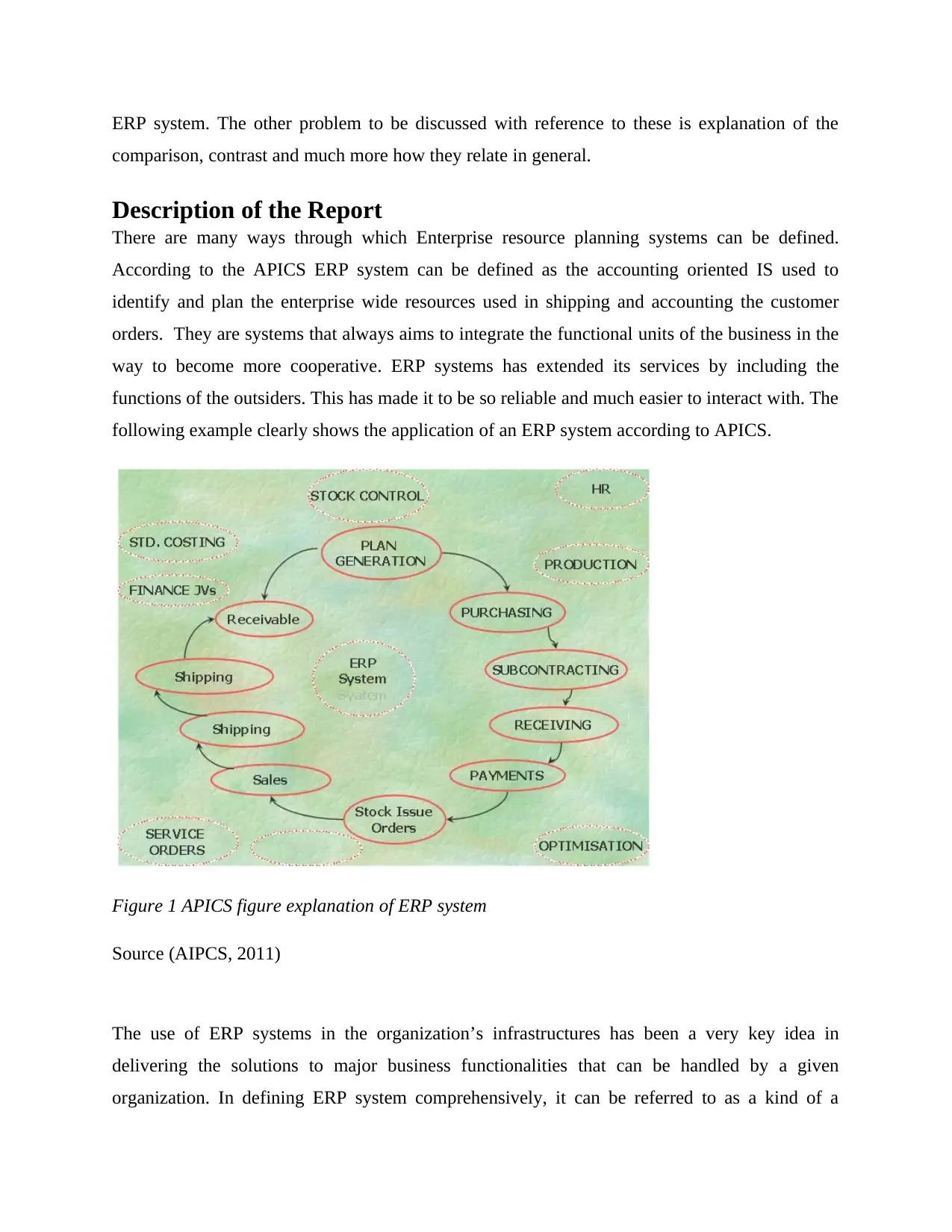
ERP system. The other problem to be discussed with reference to these is explanation of the
comparison, contrast and much more how they relate in general.
Description of the Report
There are many ways through which Enterprise resource planning systems can be defined.
According to the APICS ERP system can be defined as the accounting oriented IS used to
identify and plan the enterprise wide resources used in shipping and accounting the customer
orders. They are systems that always aims to integrate the functional units of the business in the
way to become more cooperative. ERP systems has extended its services by including the
functions of the outsiders. This has made it to be so reliable and much easier to interact with. The
following example clearly shows the application of an ERP system according to APICS.
Figure 1 APICS figure explanation of ERP system
Source (AIPCS, 2011)
The use of ERP systems in the organization’s infrastructures has been a very key idea in
delivering the solutions to major business functionalities that can be handled by a given
organization. In defining ERP system comprehensively, it can be referred to as a kind of a
comparison, contrast and much more how they relate in general.
Description of the Report
There are many ways through which Enterprise resource planning systems can be defined.
According to the APICS ERP system can be defined as the accounting oriented IS used to
identify and plan the enterprise wide resources used in shipping and accounting the customer
orders. They are systems that always aims to integrate the functional units of the business in the
way to become more cooperative. ERP systems has extended its services by including the
functions of the outsiders. This has made it to be so reliable and much easier to interact with. The
following example clearly shows the application of an ERP system according to APICS.
Figure 1 APICS figure explanation of ERP system
Source (AIPCS, 2011)
The use of ERP systems in the organization’s infrastructures has been a very key idea in
delivering the solutions to major business functionalities that can be handled by a given
organization. In defining ERP system comprehensively, it can be referred to as a kind of a
Secure Best Marks with AI Grader
Need help grading? Try our AI Grader for instant feedback on your assignments.
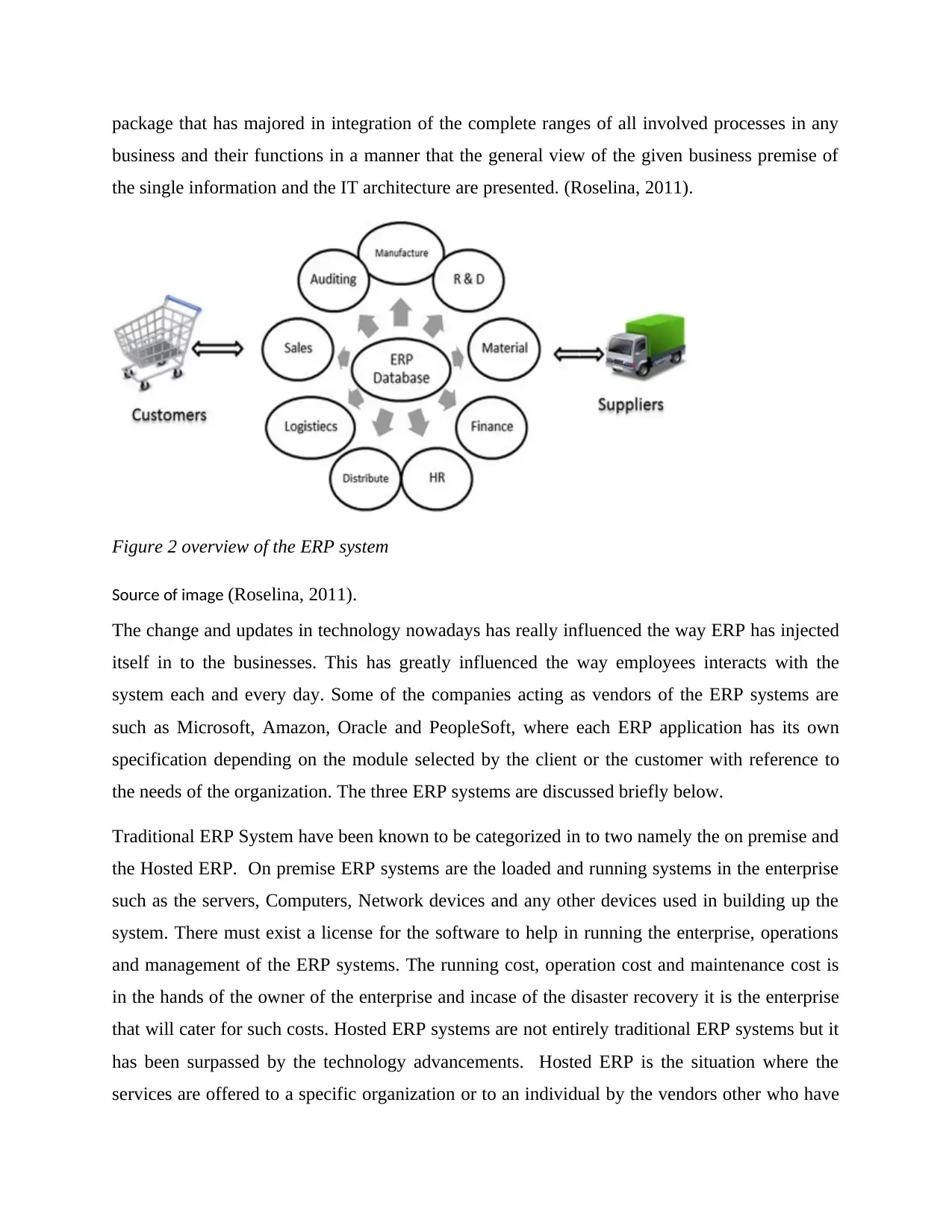
package that has majored in integration of the complete ranges of all involved processes in any
business and their functions in a manner that the general view of the given business premise of
the single information and the IT architecture are presented. (Roselina, 2011).
Figure 2 overview of the ERP system
Source of image (Roselina, 2011).
The change and updates in technology nowadays has really influenced the way ERP has injected
itself in to the businesses. This has greatly influenced the way employees interacts with the
system each and every day. Some of the companies acting as vendors of the ERP systems are
such as Microsoft, Amazon, Oracle and PeopleSoft, where each ERP application has its own
specification depending on the module selected by the client or the customer with reference to
the needs of the organization. The three ERP systems are discussed briefly below.
Traditional ERP System have been known to be categorized in to two namely the on premise and
the Hosted ERP. On premise ERP systems are the loaded and running systems in the enterprise
such as the servers, Computers, Network devices and any other devices used in building up the
system. There must exist a license for the software to help in running the enterprise, operations
and management of the ERP systems. The running cost, operation cost and maintenance cost is
in the hands of the owner of the enterprise and incase of the disaster recovery it is the enterprise
that will cater for such costs. Hosted ERP systems are not entirely traditional ERP systems but it
has been surpassed by the technology advancements. Hosted ERP is the situation where the
services are offered to a specific organization or to an individual by the vendors other who have
business and their functions in a manner that the general view of the given business premise of
the single information and the IT architecture are presented. (Roselina, 2011).
Figure 2 overview of the ERP system
Source of image (Roselina, 2011).
The change and updates in technology nowadays has really influenced the way ERP has injected
itself in to the businesses. This has greatly influenced the way employees interacts with the
system each and every day. Some of the companies acting as vendors of the ERP systems are
such as Microsoft, Amazon, Oracle and PeopleSoft, where each ERP application has its own
specification depending on the module selected by the client or the customer with reference to
the needs of the organization. The three ERP systems are discussed briefly below.
Traditional ERP System have been known to be categorized in to two namely the on premise and
the Hosted ERP. On premise ERP systems are the loaded and running systems in the enterprise
such as the servers, Computers, Network devices and any other devices used in building up the
system. There must exist a license for the software to help in running the enterprise, operations
and management of the ERP systems. The running cost, operation cost and maintenance cost is
in the hands of the owner of the enterprise and incase of the disaster recovery it is the enterprise
that will cater for such costs. Hosted ERP systems are not entirely traditional ERP systems but it
has been surpassed by the technology advancements. Hosted ERP is the situation where the
services are offered to a specific organization or to an individual by the vendors other who have

servers in remote areas (Peddoju, 2014). There are in many situations that such facility in most
cases it is offered in situation where there is a network throughout and that is directly connected
and running via the internet.
On-premise ERP systems.
This type of ERP system is known for offering the control and much more the security. This
types of software’s are known as they run in the in-house servers at any given location of the
company which is always controlled by the company. On premise has been known for offering
high security and much more enough control of the specific company. The major reason for the
above satisfying security and control is it using the IT infrastructures in the organization to
connect to people. The On Premise ERP systems have extended and thus adapting to the
requirement changes. Some of the changes experienced in the when using the On Premise ERP
systems are such as:
1. It is applicable when in need of supervision and security of ERP systems and the
deployment of the data controlled by the company.
2. When the company may be in need of specializing its integration within the systems in
their industries when dealing with the daily functions and the operations.
3. When the company has dedicated all the resources it owns to the onsite thus handling the
services and the maintenance of the applications installed.
Advantages of an ON Premise ERP system
The confidentiality of the data will remain secure on the onsite application
The company will have full control of all the data that is processed from within the
premises.
There is robust integration which may be an option in other options.
There are options for robust customization (Computing, 2018).
Comparison and Contrast between Cloud ERP systems and the On premises (Pros and
Cons)
There are so many comparisons with regards to the two when it comes to checking how they are
operated. Cloud ERP systems are the modern known type of ERP systems which have made their
services to be entirely on the cloud. They possess the full control of your information. The client
is only given the login credentials and thus this make the vendors the controller of everything as
cases it is offered in situation where there is a network throughout and that is directly connected
and running via the internet.
On-premise ERP systems.
This type of ERP system is known for offering the control and much more the security. This
types of software’s are known as they run in the in-house servers at any given location of the
company which is always controlled by the company. On premise has been known for offering
high security and much more enough control of the specific company. The major reason for the
above satisfying security and control is it using the IT infrastructures in the organization to
connect to people. The On Premise ERP systems have extended and thus adapting to the
requirement changes. Some of the changes experienced in the when using the On Premise ERP
systems are such as:
1. It is applicable when in need of supervision and security of ERP systems and the
deployment of the data controlled by the company.
2. When the company may be in need of specializing its integration within the systems in
their industries when dealing with the daily functions and the operations.
3. When the company has dedicated all the resources it owns to the onsite thus handling the
services and the maintenance of the applications installed.
Advantages of an ON Premise ERP system
The confidentiality of the data will remain secure on the onsite application
The company will have full control of all the data that is processed from within the
premises.
There is robust integration which may be an option in other options.
There are options for robust customization (Computing, 2018).
Comparison and Contrast between Cloud ERP systems and the On premises (Pros and
Cons)
There are so many comparisons with regards to the two when it comes to checking how they are
operated. Cloud ERP systems are the modern known type of ERP systems which have made their
services to be entirely on the cloud. They possess the full control of your information. The client
is only given the login credentials and thus this make the vendors the controller of everything as

they act as the admin on both sides. These will be tackled basing the argument on the cost,
Security, scalability and deployment and the user access. The following tables is used to discuss
such in details.
Comparison in terms of Pros
Cloud On-Premises
Security, scalability and deployment and the user access. The following tables is used to discuss
such in details.
Comparison in terms of Pros
Cloud On-Premises
Paraphrase This Document
Need a fresh take? Get an instant paraphrase of this document with our AI Paraphraser

Pros
Cost There is a lower
upfront cost. This
means that costs of
cloud SaaS may be
classified as OPEX
which has been
known for reducing
the approved need of
the large CAPEX
during any given year.
Storage cost of the
cloud has continued to
be very low as there is
no extra cost for the
purchase of
equipment’s.
The cost of
maintenance is
omitted though it is
sometimes included in
the cost monthly and
it is not considered as
an additional fee and
thus it may make the
budget to be very easy
when preparing it.
There is a lower long
term cost. In the long
term the company is
given a one-time
license.
There are no monthly
costs where the on-
premises deployments
will be are always
structured annually by
elimination need for
the costs monthly.
There is virtualization
as the owned servers
are virtualized and
always shared for the
needs internally at their
won discretion.
Security The environment is
secure as the many
vendors offering
There is customization
of the security as the
individuals can process
Cost There is a lower
upfront cost. This
means that costs of
cloud SaaS may be
classified as OPEX
which has been
known for reducing
the approved need of
the large CAPEX
during any given year.
Storage cost of the
cloud has continued to
be very low as there is
no extra cost for the
purchase of
equipment’s.
The cost of
maintenance is
omitted though it is
sometimes included in
the cost monthly and
it is not considered as
an additional fee and
thus it may make the
budget to be very easy
when preparing it.
There is a lower long
term cost. In the long
term the company is
given a one-time
license.
There are no monthly
costs where the on-
premises deployments
will be are always
structured annually by
elimination need for
the costs monthly.
There is virtualization
as the owned servers
are virtualized and
always shared for the
needs internally at their
won discretion.
Security The environment is
secure as the many
vendors offering
There is customization
of the security as the
individuals can process
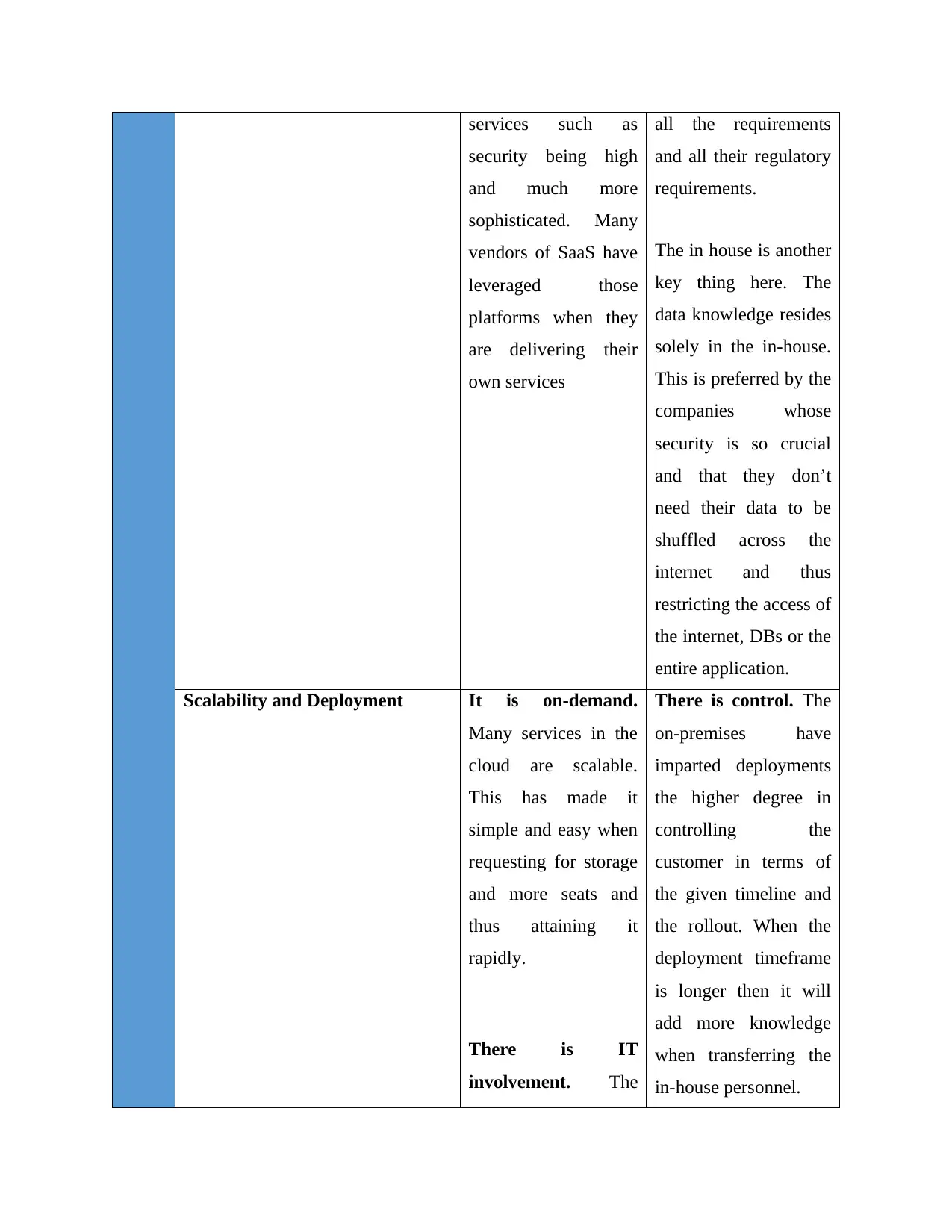
services such as
security being high
and much more
sophisticated. Many
vendors of SaaS have
leveraged those
platforms when they
are delivering their
own services
all the requirements
and all their regulatory
requirements.
The in house is another
key thing here. The
data knowledge resides
solely in the in-house.
This is preferred by the
companies whose
security is so crucial
and that they don’t
need their data to be
shuffled across the
internet and thus
restricting the access of
the internet, DBs or the
entire application.
Scalability and Deployment It is on-demand.
Many services in the
cloud are scalable.
This has made it
simple and easy when
requesting for storage
and more seats and
thus attaining it
rapidly.
There is IT
involvement. The
There is control. The
on-premises have
imparted deployments
the higher degree in
controlling the
customer in terms of
the given timeline and
the rollout. When the
deployment timeframe
is longer then it will
add more knowledge
when transferring the
in-house personnel.
security being high
and much more
sophisticated. Many
vendors of SaaS have
leveraged those
platforms when they
are delivering their
own services
all the requirements
and all their regulatory
requirements.
The in house is another
key thing here. The
data knowledge resides
solely in the in-house.
This is preferred by the
companies whose
security is so crucial
and that they don’t
need their data to be
shuffled across the
internet and thus
restricting the access of
the internet, DBs or the
entire application.
Scalability and Deployment It is on-demand.
Many services in the
cloud are scalable.
This has made it
simple and easy when
requesting for storage
and more seats and
thus attaining it
rapidly.
There is IT
involvement. The
There is control. The
on-premises have
imparted deployments
the higher degree in
controlling the
customer in terms of
the given timeline and
the rollout. When the
deployment timeframe
is longer then it will
add more knowledge
when transferring the
in-house personnel.

services in the cloud
will need less
involvement of IT and
also less in-house in
terms of the skills for
deploying, updating
and changing. The
software updates and
backups are achieved
by normal vendors
and updates being
done on the on
premise often and
frequently.
The mobile workers.
Service in the cloud
will always require
connectivity of
internet. With easy
access to the wired
and wireless
broadband and thus
becoming cheaper
thus this has made it
to be available
everywhere. It is
known for offering
provisions of easy
access for all the
remote workers via
many devices.
Internet connectivity.
The on premises are
known as they can also
run without the
internet. This has been
very useful in keeping
the mission to be
critical apps running.
will need less
involvement of IT and
also less in-house in
terms of the skills for
deploying, updating
and changing. The
software updates and
backups are achieved
by normal vendors
and updates being
done on the on
premise often and
frequently.
The mobile workers.
Service in the cloud
will always require
connectivity of
internet. With easy
access to the wired
and wireless
broadband and thus
becoming cheaper
thus this has made it
to be available
everywhere. It is
known for offering
provisions of easy
access for all the
remote workers via
many devices.
Internet connectivity.
The on premises are
known as they can also
run without the
internet. This has been
very useful in keeping
the mission to be
critical apps running.
Secure Best Marks with AI Grader
Need help grading? Try our AI Grader for instant feedback on your assignments.
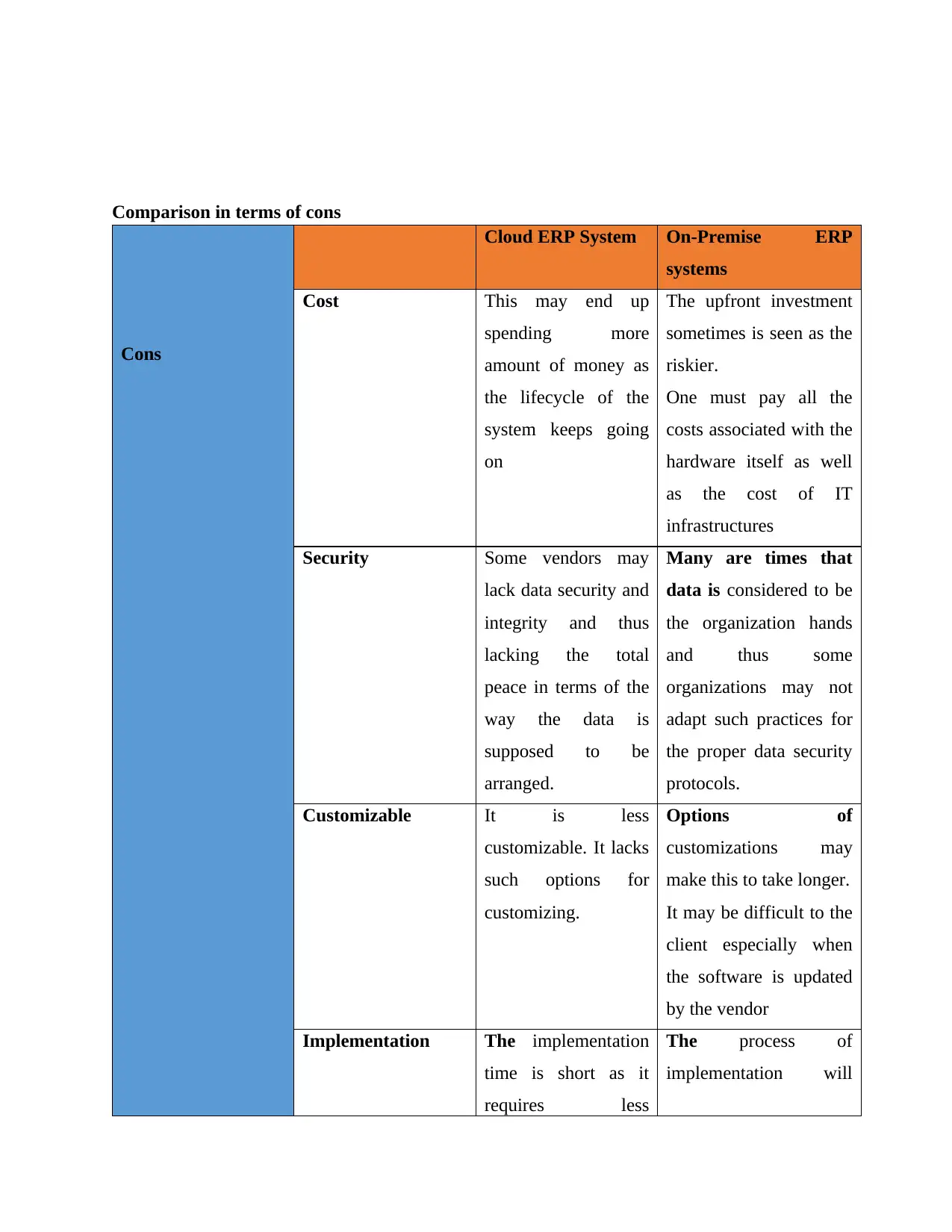
Comparison in terms of cons
Cons
Cloud ERP System On-Premise ERP
systems
Cost This may end up
spending more
amount of money as
the lifecycle of the
system keeps going
on
The upfront investment
sometimes is seen as the
riskier.
One must pay all the
costs associated with the
hardware itself as well
as the cost of IT
infrastructures
Security Some vendors may
lack data security and
integrity and thus
lacking the total
peace in terms of the
way the data is
supposed to be
arranged.
Many are times that
data is considered to be
the organization hands
and thus some
organizations may not
adapt such practices for
the proper data security
protocols.
Customizable It is less
customizable. It lacks
such options for
customizing.
Options of
customizations may
make this to take longer.
It may be difficult to the
client especially when
the software is updated
by the vendor
Implementation The implementation
time is short as it
requires less
The process of
implementation will
Cons
Cloud ERP System On-Premise ERP
systems
Cost This may end up
spending more
amount of money as
the lifecycle of the
system keeps going
on
The upfront investment
sometimes is seen as the
riskier.
One must pay all the
costs associated with the
hardware itself as well
as the cost of IT
infrastructures
Security Some vendors may
lack data security and
integrity and thus
lacking the total
peace in terms of the
way the data is
supposed to be
arranged.
Many are times that
data is considered to be
the organization hands
and thus some
organizations may not
adapt such practices for
the proper data security
protocols.
Customizable It is less
customizable. It lacks
such options for
customizing.
Options of
customizations may
make this to take longer.
It may be difficult to the
client especially when
the software is updated
by the vendor
Implementation The implementation
time is short as it
requires less
The process of
implementation will
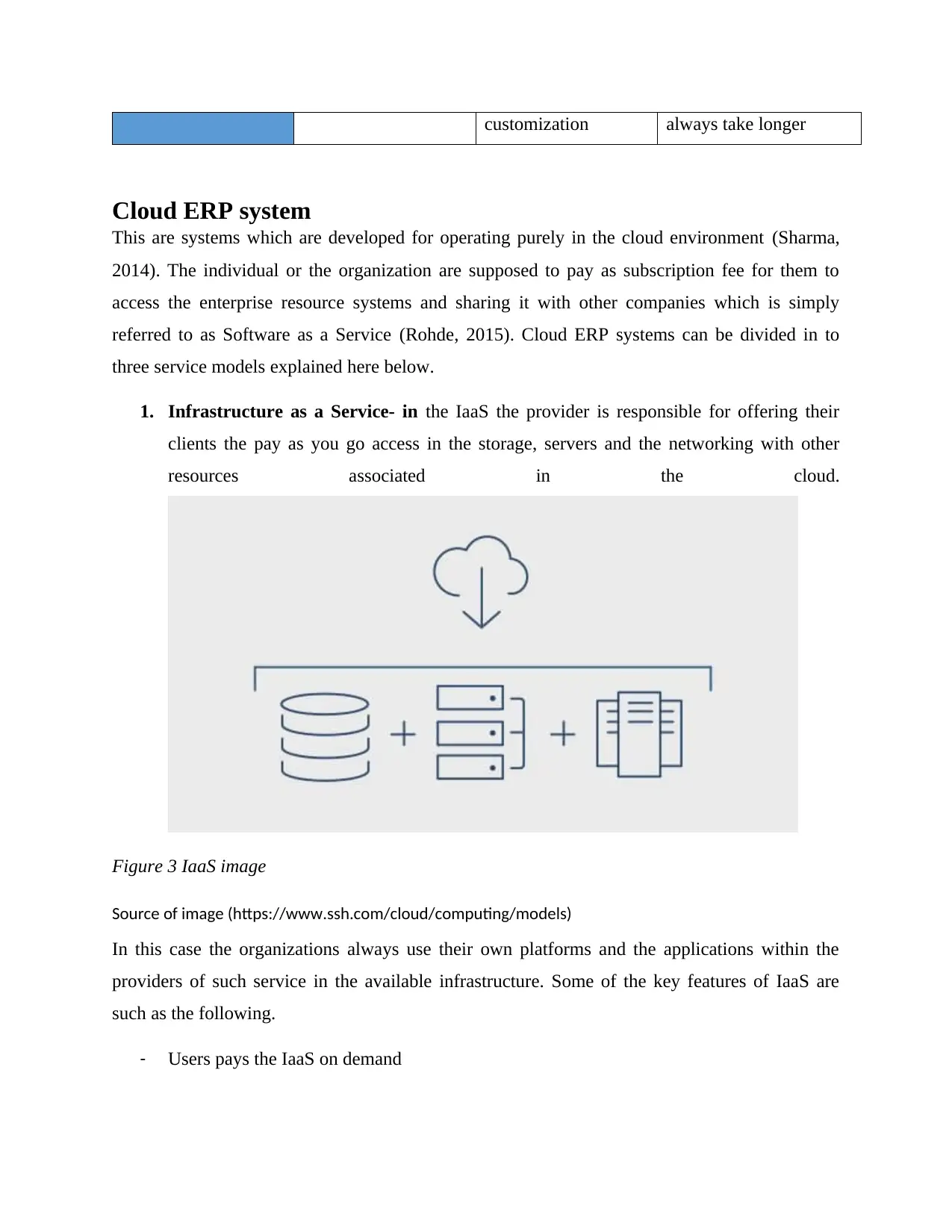
customization always take longer
Cloud ERP system
This are systems which are developed for operating purely in the cloud environment (Sharma,
2014). The individual or the organization are supposed to pay as subscription fee for them to
access the enterprise resource systems and sharing it with other companies which is simply
referred to as Software as a Service (Rohde, 2015). Cloud ERP systems can be divided in to
three service models explained here below.
1. Infrastructure as a Service- in the IaaS the provider is responsible for offering their
clients the pay as you go access in the storage, servers and the networking with other
resources associated in the cloud.
Figure 3 IaaS image
Source of image (https://www.ssh.com/cloud/computing/models)
In this case the organizations always use their own platforms and the applications within the
providers of such service in the available infrastructure. Some of the key features of IaaS are
such as the following.
- Users pays the IaaS on demand
Cloud ERP system
This are systems which are developed for operating purely in the cloud environment (Sharma,
2014). The individual or the organization are supposed to pay as subscription fee for them to
access the enterprise resource systems and sharing it with other companies which is simply
referred to as Software as a Service (Rohde, 2015). Cloud ERP systems can be divided in to
three service models explained here below.
1. Infrastructure as a Service- in the IaaS the provider is responsible for offering their
clients the pay as you go access in the storage, servers and the networking with other
resources associated in the cloud.
Figure 3 IaaS image
Source of image (https://www.ssh.com/cloud/computing/models)
In this case the organizations always use their own platforms and the applications within the
providers of such service in the available infrastructure. Some of the key features of IaaS are
such as the following.
- Users pays the IaaS on demand
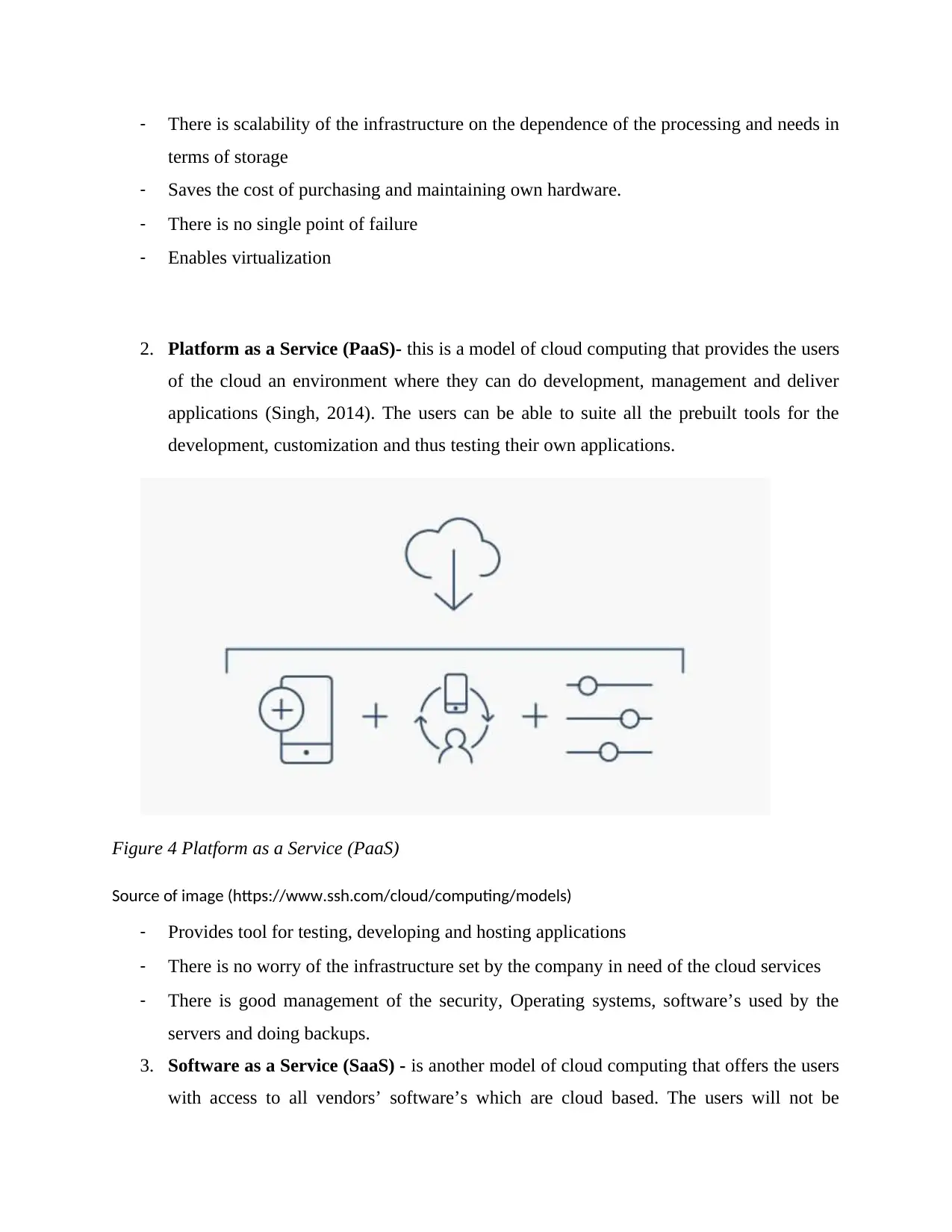
- There is scalability of the infrastructure on the dependence of the processing and needs in
terms of storage
- Saves the cost of purchasing and maintaining own hardware.
- There is no single point of failure
- Enables virtualization
2. Platform as a Service (PaaS)- this is a model of cloud computing that provides the users
of the cloud an environment where they can do development, management and deliver
applications (Singh, 2014). The users can be able to suite all the prebuilt tools for the
development, customization and thus testing their own applications.
Figure 4 Platform as a Service (PaaS)
Source of image (https://www.ssh.com/cloud/computing/models)
- Provides tool for testing, developing and hosting applications
- There is no worry of the infrastructure set by the company in need of the cloud services
- There is good management of the security, Operating systems, software’s used by the
servers and doing backups.
3. Software as a Service (SaaS) - is another model of cloud computing that offers the users
with access to all vendors’ software’s which are cloud based. The users will not be
terms of storage
- Saves the cost of purchasing and maintaining own hardware.
- There is no single point of failure
- Enables virtualization
2. Platform as a Service (PaaS)- this is a model of cloud computing that provides the users
of the cloud an environment where they can do development, management and deliver
applications (Singh, 2014). The users can be able to suite all the prebuilt tools for the
development, customization and thus testing their own applications.
Figure 4 Platform as a Service (PaaS)
Source of image (https://www.ssh.com/cloud/computing/models)
- Provides tool for testing, developing and hosting applications
- There is no worry of the infrastructure set by the company in need of the cloud services
- There is good management of the security, Operating systems, software’s used by the
servers and doing backups.
3. Software as a Service (SaaS) - is another model of cloud computing that offers the users
with access to all vendors’ software’s which are cloud based. The users will not be
Paraphrase This Document
Need a fresh take? Get an instant paraphrase of this document with our AI Paraphraser
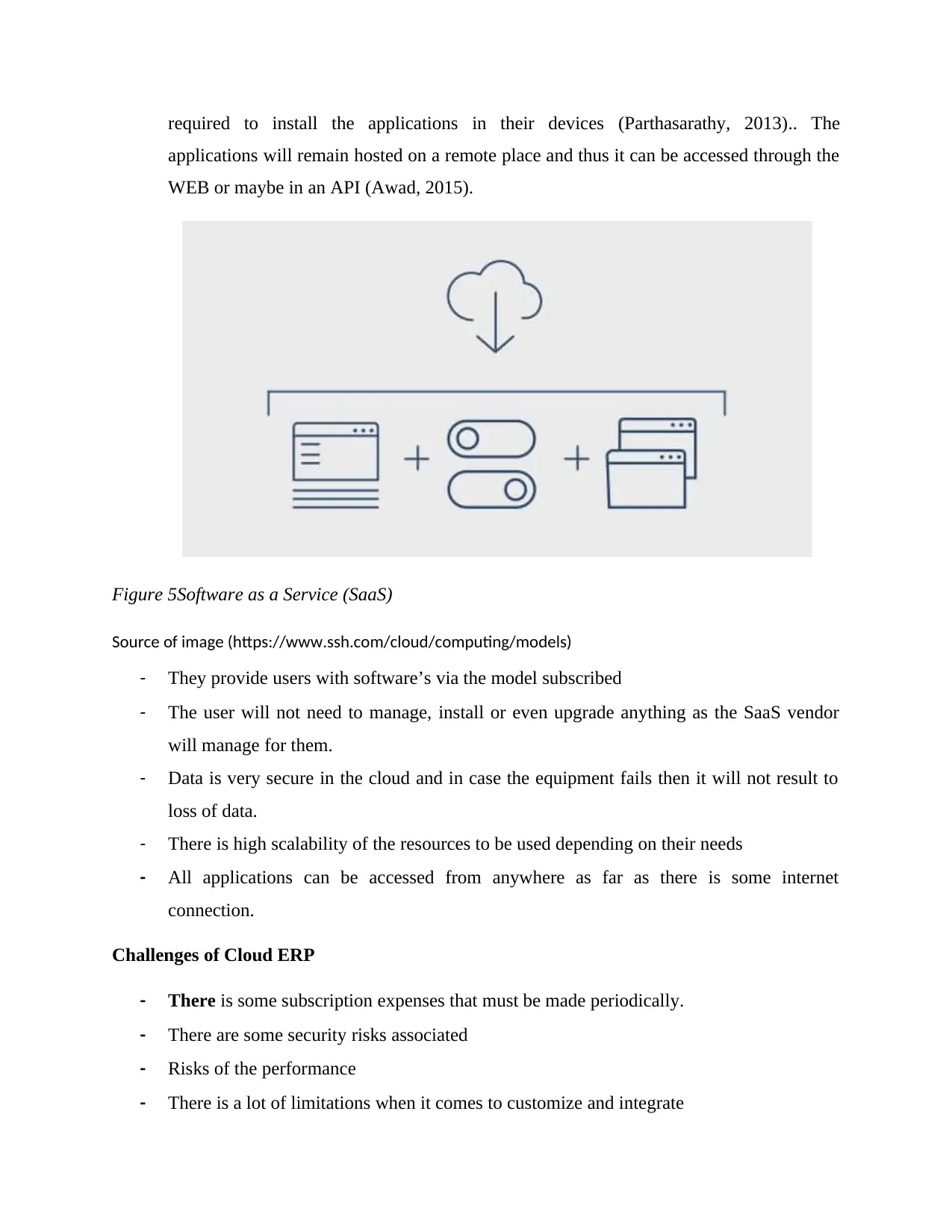
required to install the applications in their devices (Parthasarathy, 2013).. The
applications will remain hosted on a remote place and thus it can be accessed through the
WEB or maybe in an API (Awad, 2015).
Figure 5Software as a Service (SaaS)
Source of image (https://www.ssh.com/cloud/computing/models)
- They provide users with software’s via the model subscribed
- The user will not need to manage, install or even upgrade anything as the SaaS vendor
will manage for them.
- Data is very secure in the cloud and in case the equipment fails then it will not result to
loss of data.
- There is high scalability of the resources to be used depending on their needs
- All applications can be accessed from anywhere as far as there is some internet
connection.
Challenges of Cloud ERP
- There is some subscription expenses that must be made periodically.
- There are some security risks associated
- Risks of the performance
- There is a lot of limitations when it comes to customize and integrate
applications will remain hosted on a remote place and thus it can be accessed through the
WEB or maybe in an API (Awad, 2015).
Figure 5Software as a Service (SaaS)
Source of image (https://www.ssh.com/cloud/computing/models)
- They provide users with software’s via the model subscribed
- The user will not need to manage, install or even upgrade anything as the SaaS vendor
will manage for them.
- Data is very secure in the cloud and in case the equipment fails then it will not result to
loss of data.
- There is high scalability of the resources to be used depending on their needs
- All applications can be accessed from anywhere as far as there is some internet
connection.
Challenges of Cloud ERP
- There is some subscription expenses that must be made periodically.
- There are some security risks associated
- Risks of the performance
- There is a lot of limitations when it comes to customize and integrate
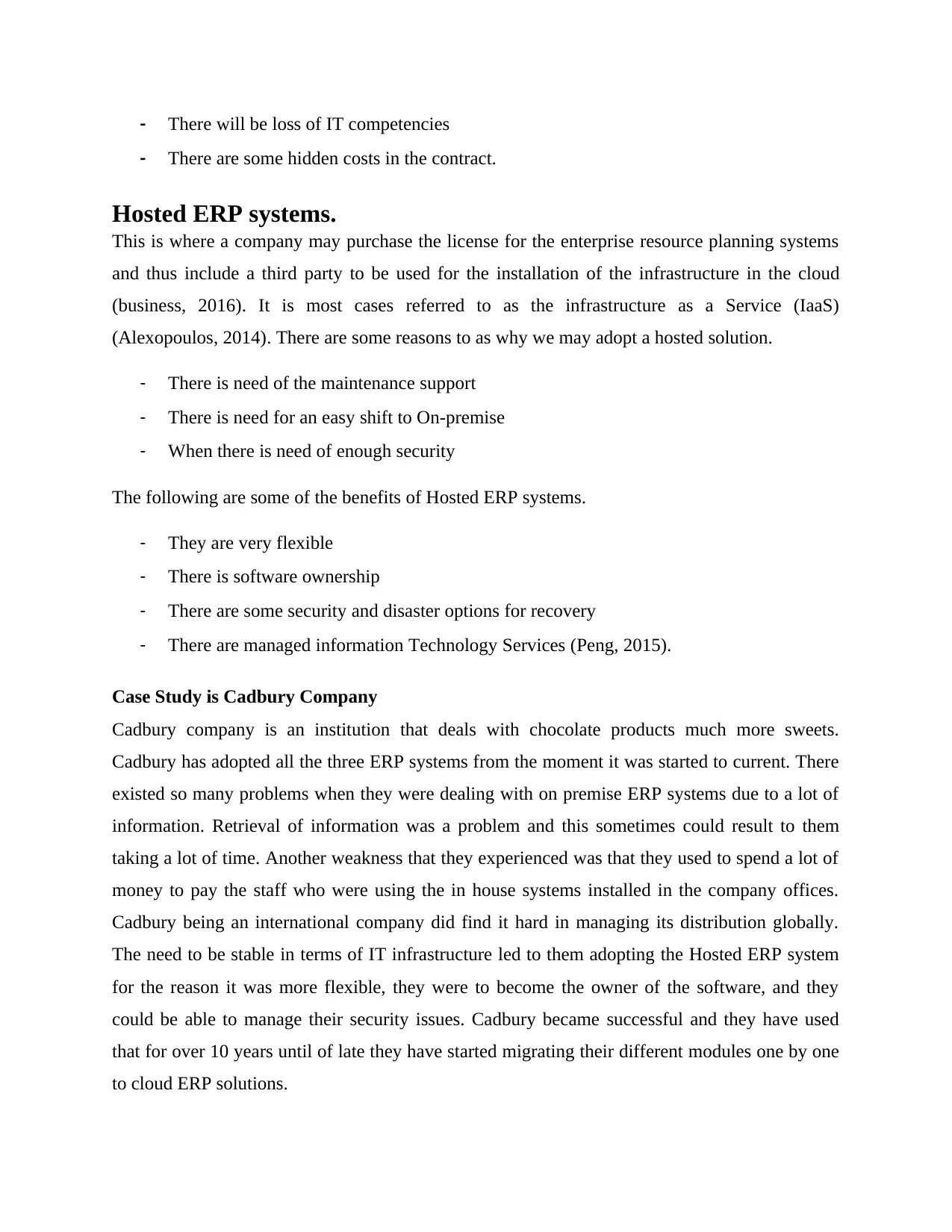
- There will be loss of IT competencies
- There are some hidden costs in the contract.
Hosted ERP systems.
This is where a company may purchase the license for the enterprise resource planning systems
and thus include a third party to be used for the installation of the infrastructure in the cloud
(business, 2016). It is most cases referred to as the infrastructure as a Service (IaaS)
(Alexopoulos, 2014). There are some reasons to as why we may adopt a hosted solution.
- There is need of the maintenance support
- There is need for an easy shift to On-premise
- When there is need of enough security
The following are some of the benefits of Hosted ERP systems.
- They are very flexible
- There is software ownership
- There are some security and disaster options for recovery
- There are managed information Technology Services (Peng, 2015).
Case Study is Cadbury Company
Cadbury company is an institution that deals with chocolate products much more sweets.
Cadbury has adopted all the three ERP systems from the moment it was started to current. There
existed so many problems when they were dealing with on premise ERP systems due to a lot of
information. Retrieval of information was a problem and this sometimes could result to them
taking a lot of time. Another weakness that they experienced was that they used to spend a lot of
money to pay the staff who were using the in house systems installed in the company offices.
Cadbury being an international company did find it hard in managing its distribution globally.
The need to be stable in terms of IT infrastructure led to them adopting the Hosted ERP system
for the reason it was more flexible, they were to become the owner of the software, and they
could be able to manage their security issues. Cadbury became successful and they have used
that for over 10 years until of late they have started migrating their different modules one by one
to cloud ERP solutions.
- There are some hidden costs in the contract.
Hosted ERP systems.
This is where a company may purchase the license for the enterprise resource planning systems
and thus include a third party to be used for the installation of the infrastructure in the cloud
(business, 2016). It is most cases referred to as the infrastructure as a Service (IaaS)
(Alexopoulos, 2014). There are some reasons to as why we may adopt a hosted solution.
- There is need of the maintenance support
- There is need for an easy shift to On-premise
- When there is need of enough security
The following are some of the benefits of Hosted ERP systems.
- They are very flexible
- There is software ownership
- There are some security and disaster options for recovery
- There are managed information Technology Services (Peng, 2015).
Case Study is Cadbury Company
Cadbury company is an institution that deals with chocolate products much more sweets.
Cadbury has adopted all the three ERP systems from the moment it was started to current. There
existed so many problems when they were dealing with on premise ERP systems due to a lot of
information. Retrieval of information was a problem and this sometimes could result to them
taking a lot of time. Another weakness that they experienced was that they used to spend a lot of
money to pay the staff who were using the in house systems installed in the company offices.
Cadbury being an international company did find it hard in managing its distribution globally.
The need to be stable in terms of IT infrastructure led to them adopting the Hosted ERP system
for the reason it was more flexible, they were to become the owner of the software, and they
could be able to manage their security issues. Cadbury became successful and they have used
that for over 10 years until of late they have started migrating their different modules one by one
to cloud ERP solutions.
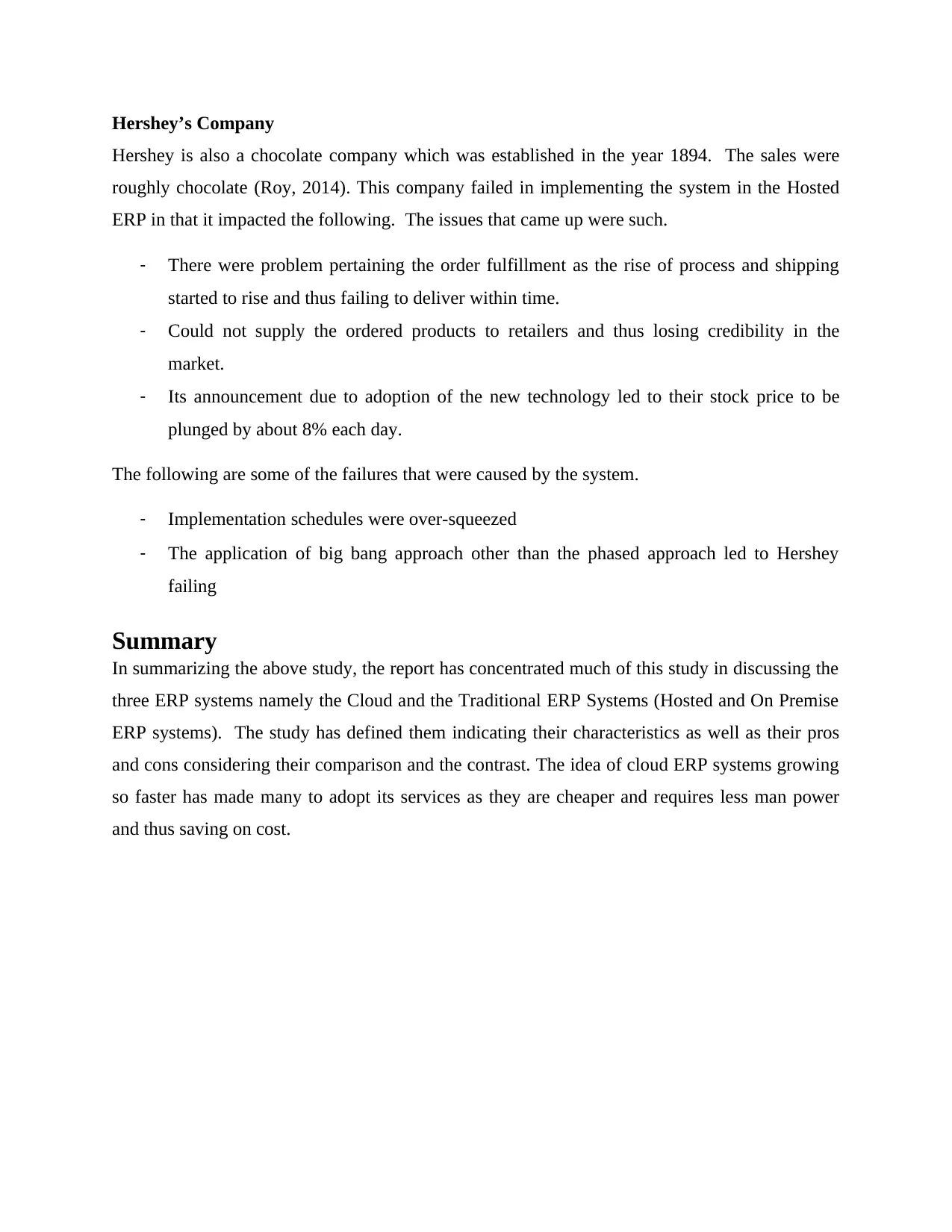
Hershey’s Company
Hershey is also a chocolate company which was established in the year 1894. The sales were
roughly chocolate (Roy, 2014). This company failed in implementing the system in the Hosted
ERP in that it impacted the following. The issues that came up were such.
- There were problem pertaining the order fulfillment as the rise of process and shipping
started to rise and thus failing to deliver within time.
- Could not supply the ordered products to retailers and thus losing credibility in the
market.
- Its announcement due to adoption of the new technology led to their stock price to be
plunged by about 8% each day.
The following are some of the failures that were caused by the system.
- Implementation schedules were over-squeezed
- The application of big bang approach other than the phased approach led to Hershey
failing
Summary
In summarizing the above study, the report has concentrated much of this study in discussing the
three ERP systems namely the Cloud and the Traditional ERP Systems (Hosted and On Premise
ERP systems). The study has defined them indicating their characteristics as well as their pros
and cons considering their comparison and the contrast. The idea of cloud ERP systems growing
so faster has made many to adopt its services as they are cheaper and requires less man power
and thus saving on cost.
Hershey is also a chocolate company which was established in the year 1894. The sales were
roughly chocolate (Roy, 2014). This company failed in implementing the system in the Hosted
ERP in that it impacted the following. The issues that came up were such.
- There were problem pertaining the order fulfillment as the rise of process and shipping
started to rise and thus failing to deliver within time.
- Could not supply the ordered products to retailers and thus losing credibility in the
market.
- Its announcement due to adoption of the new technology led to their stock price to be
plunged by about 8% each day.
The following are some of the failures that were caused by the system.
- Implementation schedules were over-squeezed
- The application of big bang approach other than the phased approach led to Hershey
failing
Summary
In summarizing the above study, the report has concentrated much of this study in discussing the
three ERP systems namely the Cloud and the Traditional ERP Systems (Hosted and On Premise
ERP systems). The study has defined them indicating their characteristics as well as their pros
and cons considering their comparison and the contrast. The idea of cloud ERP systems growing
so faster has made many to adopt its services as they are cheaper and requires less man power
and thus saving on cost.
Secure Best Marks with AI Grader
Need help grading? Try our AI Grader for instant feedback on your assignments.
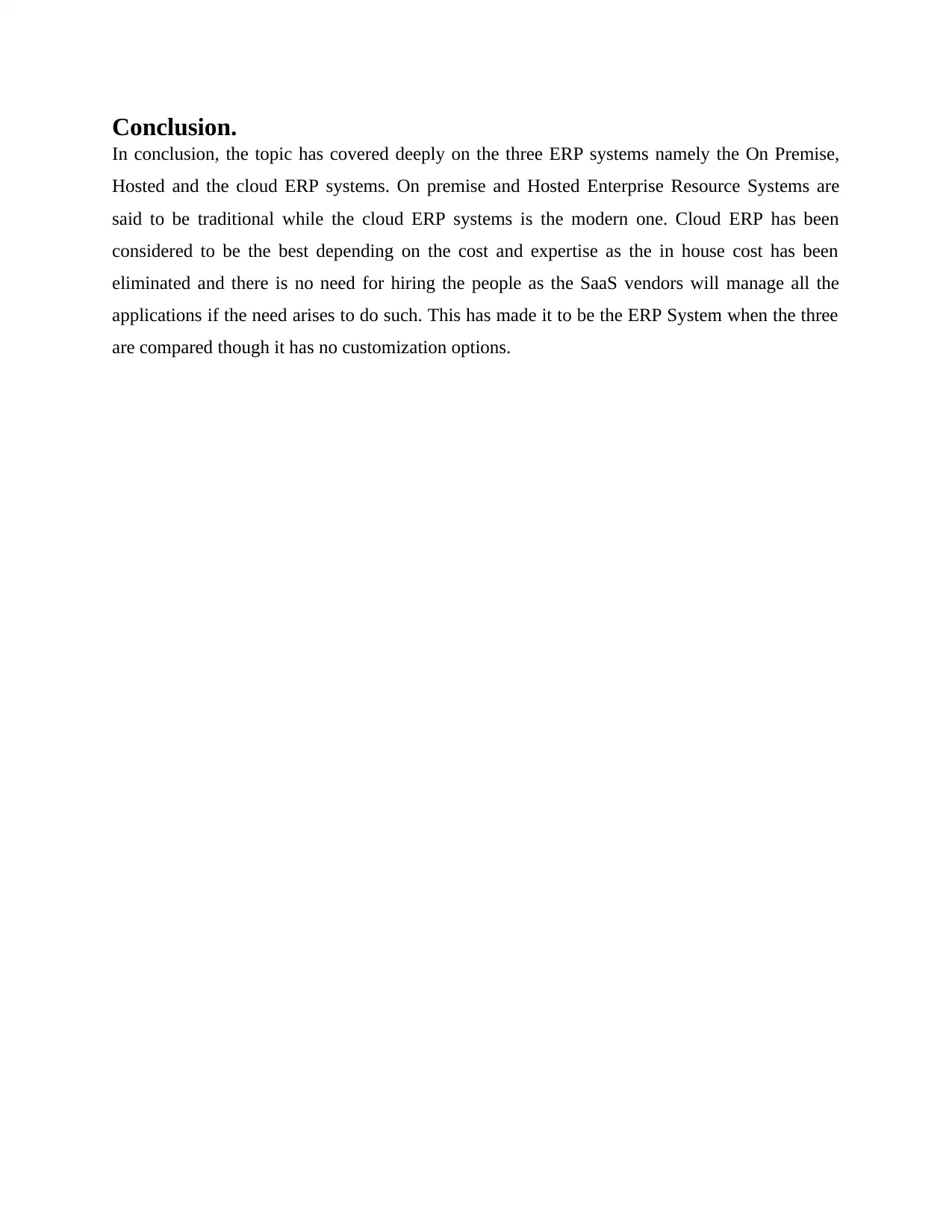
Conclusion.
In conclusion, the topic has covered deeply on the three ERP systems namely the On Premise,
Hosted and the cloud ERP systems. On premise and Hosted Enterprise Resource Systems are
said to be traditional while the cloud ERP systems is the modern one. Cloud ERP has been
considered to be the best depending on the cost and expertise as the in house cost has been
eliminated and there is no need for hiring the people as the SaaS vendors will manage all the
applications if the need arises to do such. This has made it to be the ERP System when the three
are compared though it has no customization options.
In conclusion, the topic has covered deeply on the three ERP systems namely the On Premise,
Hosted and the cloud ERP systems. On premise and Hosted Enterprise Resource Systems are
said to be traditional while the cloud ERP systems is the modern one. Cloud ERP has been
considered to be the best depending on the cost and expertise as the in house cost has been
eliminated and there is no need for hiring the people as the SaaS vendors will manage all the
applications if the need arises to do such. This has made it to be the ERP System when the three
are compared though it has no customization options.
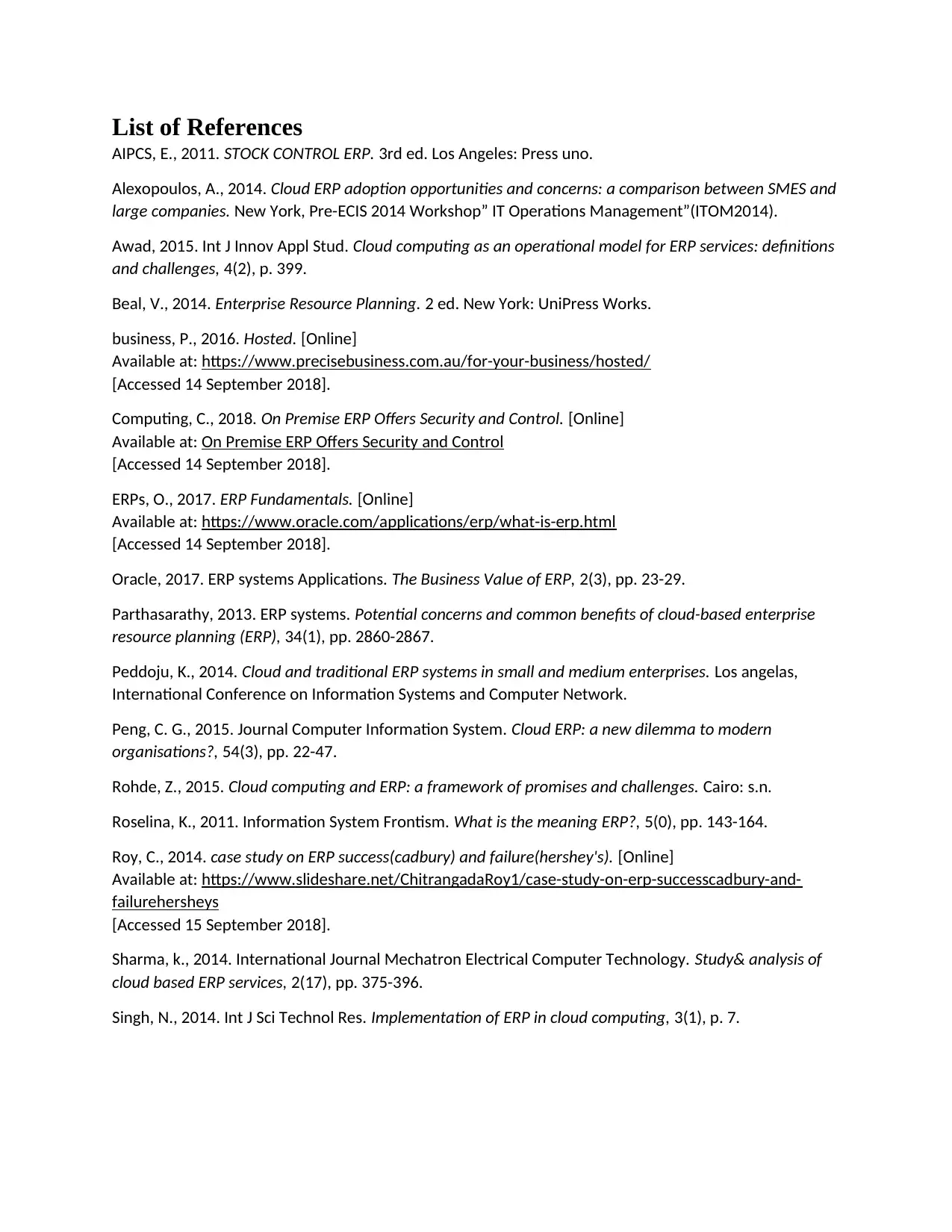
List of References
AIPCS, E., 2011. STOCK CONTROL ERP. 3rd ed. Los Angeles: Press uno.
Alexopoulos, A., 2014. Cloud ERP adoption opportunities and concerns: a comparison between SMES and
large companies. New York, Pre-ECIS 2014 Workshop” IT Operations Management”(ITOM2014).
Awad, 2015. Int J Innov Appl Stud. Cloud computing as an operational model for ERP services: definitions
and challenges, 4(2), p. 399.
Beal, V., 2014. Enterprise Resource Planning. 2 ed. New York: UniPress Works.
business, P., 2016. Hosted. [Online]
Available at: https://www.precisebusiness.com.au/for-your-business/hosted/
[Accessed 14 September 2018].
Computing, C., 2018. On Premise ERP Offers Security and Control. [Online]
Available at: On Premise ERP Offers Security and Control
[Accessed 14 September 2018].
ERPs, O., 2017. ERP Fundamentals. [Online]
Available at: https://www.oracle.com/applications/erp/what-is-erp.html
[Accessed 14 September 2018].
Oracle, 2017. ERP systems Applications. The Business Value of ERP, 2(3), pp. 23-29.
Parthasarathy, 2013. ERP systems. Potential concerns and common benefits of cloud-based enterprise
resource planning (ERP), 34(1), pp. 2860-2867.
Peddoju, K., 2014. Cloud and traditional ERP systems in small and medium enterprises. Los angelas,
International Conference on Information Systems and Computer Network.
Peng, C. G., 2015. Journal Computer Information System. Cloud ERP: a new dilemma to modern
organisations?, 54(3), pp. 22-47.
Rohde, Z., 2015. Cloud computing and ERP: a framework of promises and challenges. Cairo: s.n.
Roselina, K., 2011. Information System Frontism. What is the meaning ERP?, 5(0), pp. 143-164.
Roy, C., 2014. case study on ERP success(cadbury) and failure(hershey's). [Online]
Available at: https://www.slideshare.net/ChitrangadaRoy1/case-study-on-erp-successcadbury-and-
failurehersheys
[Accessed 15 September 2018].
Sharma, k., 2014. International Journal Mechatron Electrical Computer Technology. Study& analysis of
cloud based ERP services, 2(17), pp. 375-396.
Singh, N., 2014. Int J Sci Technol Res. Implementation of ERP in cloud computing, 3(1), p. 7.
AIPCS, E., 2011. STOCK CONTROL ERP. 3rd ed. Los Angeles: Press uno.
Alexopoulos, A., 2014. Cloud ERP adoption opportunities and concerns: a comparison between SMES and
large companies. New York, Pre-ECIS 2014 Workshop” IT Operations Management”(ITOM2014).
Awad, 2015. Int J Innov Appl Stud. Cloud computing as an operational model for ERP services: definitions
and challenges, 4(2), p. 399.
Beal, V., 2014. Enterprise Resource Planning. 2 ed. New York: UniPress Works.
business, P., 2016. Hosted. [Online]
Available at: https://www.precisebusiness.com.au/for-your-business/hosted/
[Accessed 14 September 2018].
Computing, C., 2018. On Premise ERP Offers Security and Control. [Online]
Available at: On Premise ERP Offers Security and Control
[Accessed 14 September 2018].
ERPs, O., 2017. ERP Fundamentals. [Online]
Available at: https://www.oracle.com/applications/erp/what-is-erp.html
[Accessed 14 September 2018].
Oracle, 2017. ERP systems Applications. The Business Value of ERP, 2(3), pp. 23-29.
Parthasarathy, 2013. ERP systems. Potential concerns and common benefits of cloud-based enterprise
resource planning (ERP), 34(1), pp. 2860-2867.
Peddoju, K., 2014. Cloud and traditional ERP systems in small and medium enterprises. Los angelas,
International Conference on Information Systems and Computer Network.
Peng, C. G., 2015. Journal Computer Information System. Cloud ERP: a new dilemma to modern
organisations?, 54(3), pp. 22-47.
Rohde, Z., 2015. Cloud computing and ERP: a framework of promises and challenges. Cairo: s.n.
Roselina, K., 2011. Information System Frontism. What is the meaning ERP?, 5(0), pp. 143-164.
Roy, C., 2014. case study on ERP success(cadbury) and failure(hershey's). [Online]
Available at: https://www.slideshare.net/ChitrangadaRoy1/case-study-on-erp-successcadbury-and-
failurehersheys
[Accessed 15 September 2018].
Sharma, k., 2014. International Journal Mechatron Electrical Computer Technology. Study& analysis of
cloud based ERP services, 2(17), pp. 375-396.
Singh, N., 2014. Int J Sci Technol Res. Implementation of ERP in cloud computing, 3(1), p. 7.
1 out of 18
Related Documents
Your All-in-One AI-Powered Toolkit for Academic Success.
+13062052269
info@desklib.com
Available 24*7 on WhatsApp / Email
![[object Object]](/_next/static/media/star-bottom.7253800d.svg)
Unlock your academic potential
© 2024 | Zucol Services PVT LTD | All rights reserved.




